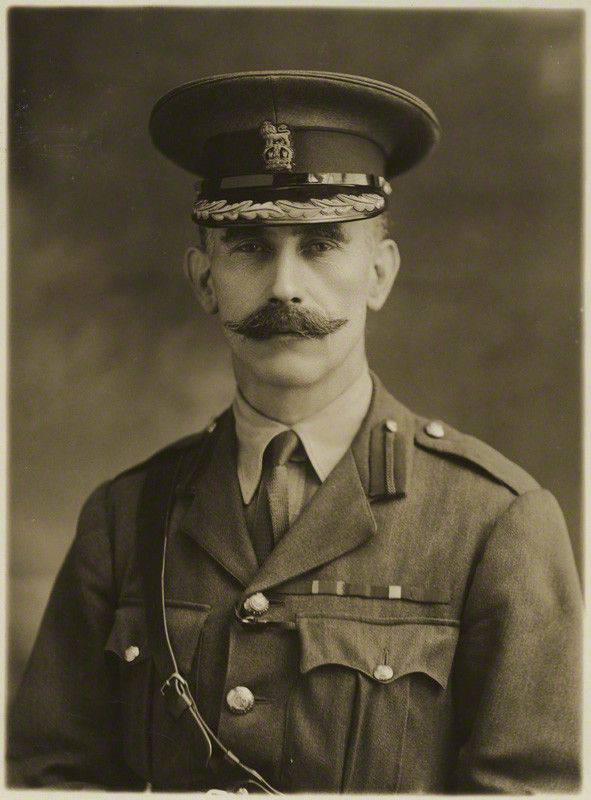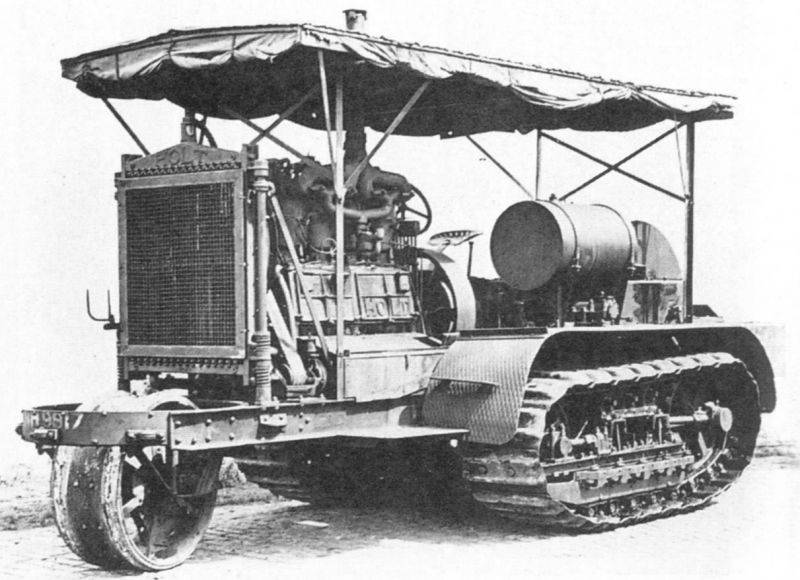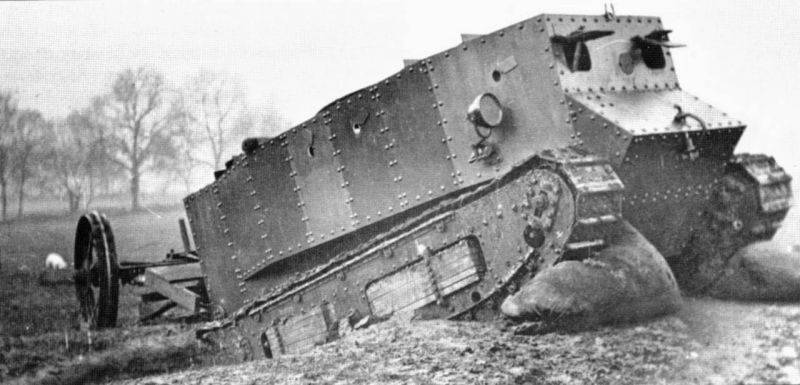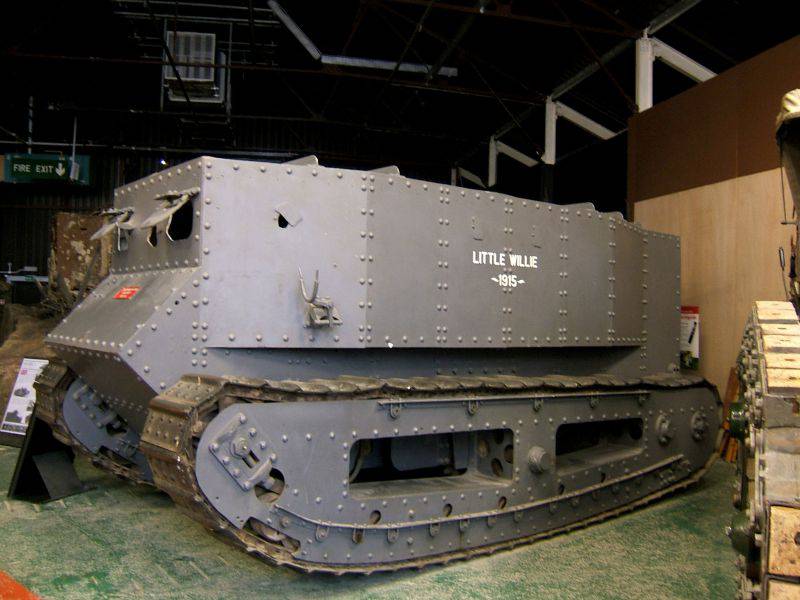Ernest Swinton - one of the first creators of the tank world
The ideas of the Italian genius remained unrealized until the beginning of the 20th century. At the same time over the creation of a new type of combat vehicles worked in many countries around the world, creating a sufficient number of prototypes. The armored train and armored car are considered to be the immediate predecessors of the modern tank, but they had significant shortcomings. For example, the range of the armored train was seriously limited, it could move only along the railway tracks. The armored car, due to the overload of the base car chassis, could not carry reinforced armament and armor, possessing low maneuverability, which also significantly limited its capabilities and scope. The car was heavily dependent on the type and features of the area.
The technical ability to build the first real tank in its modern sense appeared only with the creation of tracked tractors, which combined a high maneuverability with the ability to carry weapons and heavy armor. However, the idea of creating such a combat vehicle for a long time met with a misunderstanding of the military and their conservative views. Many considered such a tank to be an expensive trinket, which would have no place on the battlefield.

Everything was changed by the First World Warrior, who demanded a radical revision of the military doctrine from Great Britain and other countries. In particular, English Colonel Ernest Swinton, who was sent to the western front to compile reports on the course of hostilities, was personally convinced of the futility of the offensive actions of the British troops. All of their attacks ended the same way: the enemy simply "mowed" thousands of people from several machine-gun nests successfully located on the ground. From the created "positional impasse" it was possible to break out only by suppressing the enemy firing points. But the massive shelling carried out often only improved the positions of the defending troops, deepening the trenches and making the terrain difficult for their own troops. Ordinary infantry attacks also could not cope with this task.
At this moment on historical on the stage Sir Ernest Dunlop Swinton appeared (October 21, 1868 - January 15, 1951), a British officer who rose to the rank of Major General. It was he who took an active part in the creation and development of the tank as a combat vehicle during the First World War. Ernest Dunlop Swinton was born in India in the city of Bangalore in the family of an English colonial official. Both externally and in their internal “content”, Swinton was the standard of the British officer of Kipling times: a scholar, a brilliant intellectual, military engineer, commander, journalist and writer. He graduated from the Royal Military Academy, located in Woolwich. In the rank of captain took part in the Second Boer War (1899-1901), which took place in South Africa. The laconic tactical guide written by him on the actions of small units called “Defense of the Duffer Current” almost immediately became a classic, and in peacetime Ernest Siunton turned into a writer, choosing the pseudonym Ole-Lukoye, which indicated that he had a sense of humor and self-irony. The creative path fascinated him so much that he met World War I not with a British field officer, but with a war correspondent.
Like many other representatives of the British aristocracy, Ernest Dunlop Swinton linked his life with military service. Most likely, the hot blood of ancestors raged in his veins, among which were such famous personalities as the Scottish kings Robert I and Robert II. A significant role in the choice of profession was also played by Swinton’s birthplace - Indian Bangalore, “east of Suez”. In these places, the prestige of the army profession in those years was even higher than in the metropolis itself. Therefore, it is not surprising that, having graduated from the Royal Military Academy, located in Woolwich and becoming a military engineer, Sir Ernest Swinton turned out to be in the most "hot" points of the British Empire - in India and South Africa for almost 14 years.
It is believed that it was during the Anglo-Boer War, in which the well-aimed South African arrows literally mowed down the infantry chains of the British, the first time he had the idea to create a mobile firing point protected by armor. Moreover, a clear example was before his eyes. For the transfer of troops and delivery of supplies, the British already in that war began to widely use the "armored", that is, armored, steam locomotives and "locomobiles" - a kind of steam tractors that pulled several wagons with different loads.
The next time Ernest Swinton was at the forefront in the 1914 year during the First World War, he went to war as a war correspondent. Together with the usual "Tommy" - so called the British soldiers - Swinton sat in the trenches under artillery shelling, went with them through the so-called "lunar landscape" and pressed into the ground under heavy German machine-gun fire. Upon returning from the front to England in October 1914, Ernest Swinton addressed a proposal to the British War Department to create a "cruiser with a tracked tractor based on a tractor." He already realized that with such a level of losses, the United Kingdom could very quickly lose the war.
There is an opinion that, while in France, Ernest Swinton witnessed how the American crawler tractor of the inventor and industrialist Holt calmly pulled an artillery gun through the impassable mud. The invention of the Yankees simply captivated the heart of Sir Ernest - it was the tractor he saw as the "chassis" for his future offspring. It was in 1914, the idea of creating a tank finally really came to court. Stunned by the very heavy losses and the collapse of all ideas of warfare, the British generals no longer considered the next military inventor to be insane. However, they didn’t show much zeal for the new project of military equipment, believing that it would take several years to build a tank, and the war would end with any result by that moment.
It is worth noting that the Holt-Caterpillar tractor was simultaneously noticed in the UK and France, it attracted the attention of the English colonel Ernest Dunlop Swinton and the French army colonel Jean-Baptiste Eugène Etienne, respectively. It was these two characters that forever entered the history of tank building. They can even be safely called the founding fathers of the tank forces. Independently of each other, both of them were engaged in the development of the first tanks and the promotion of their ideas among the highest military circles of their countries. Ernest Swinton became the creator of the idea of the tank, its guide to life and embodiment. It was Swinton who chose the caterpillar base for the construction of a new combat vehicle, and also proposed to introduce the word "tank" (reservoir) into use. Only thanks to the authority and reports of this British colonel in the Ministry of War, developments in this direction were nevertheless started, he was entrusted with the preparation of the first tank crews, and, finally, it was Swinton who created the first tank memo.
At the same time, the project of Swinton could have remained unfulfilled even under the conditions of the bloody war unfolding in Europe, if First Lord of the Admiralty Sir Winston Churchill had not turned his attention to it. Even his arguments in defense of the new combat vehicle at first could not convince the conservative military leadership, but he would not have been Churchill if he had easily retreated. The First Lord of the Admiralty, who believed in the idea and project of Swinton and other inventors, decided to act. In January 1915, he wrote a letter to Prime Minister Lord Asquith, justifying the need to develop a "land armadillo", attaching blueprints of a new combat vehicle to the letter, and in February 1915, the future British Prime Minister founded the Land Ships Committee.
In June of the same year, Ernest Swinton was invited to this committee, who wrote specifications for a new armored combat vehicle for him. Among the main requirements for the tank, he listed: movement speed up to 6,4 km / h, sufficient maneuverability to successfully move around the battlefield, possibility of overcoming obstacles, for example, trenches up to 2,4 meter wide and earth parapets up to 1,5 m. Armament of the tank should have been be represented by two guns and two machine guns. It is worth noting that the concept and set of characteristics proposed by Swinton were much more realistic than the draft by Major Thomas Hetherington, who was clearly addicted to gigantism, considered by the Committee before. He proposed a variant of a combat vehicle armed with 6 cannons and 14 machine guns, at a height of about 14 meters and booking 80-mm precisely would not have been possible in those conditions. Even if this iron monster could be created, he would have proved his utter inconsistency already on the battlefield, becoming an easy target for enemy artillery.
The development process of a new lightweight tank that corresponded to Swinton's concept, which is now instead of the “land battleship” began to be called the “land cruiser,” was entrusted to the Marine aviation Walter Wilson and William Tritton, director of agricultural technology, William Foster & C. Limited. The author of the tank design, which was created on the basis of the requirements advanced by Swinton, was the chief engineer of the company William Rigby. The construction of the first prototype of the tank began on August 11, 1915, and only a month later the combat vehicle was presented to the commission. The tank was called Little Willie or "Little Willy." He became the first ever working prototype of the tank. After the war, it was decided to save the car for future generations, and in 1940 it was once again managed to save it from recycling for scrap. Today, "Little Willie" can still be seen live, now the tank is an exhibit of the Tank Museum in Bovington.
At the same time, during the tests of the first prototype of the tank, a number of its significant shortcomings were revealed. The first of these was low speed: on rough terrain, it could drop to 1,2 km / h, which made the combat vehicle an easy target for enemy artillery. The second problem was low permeability: the prototype could hardly overcome obstacles in the form of craters from shells and trenches, which abounded in the battlefields of the First World War. The third problem was the complexity of the control: in front of the car sat the 2 driver, one of whom was driving the steering wheel, clutch, main transmission and shifting gears, and the other with brakes. Another 2 person located near the engine, they put in action a secondary transmission. To control the weapons installed on the tank, at least 2 crew members were needed.
But the creation of the first prototype of the tank gave positive results. First, this prototype proved the perspective development of tanks. Secondly, based on the results of the tests, the basic requirements for the further development of a new type of combat vehicles were formulated, in particular, the need to increase the length of the tank in order to overcome trenches, etc. Thirdly, a pair of designers —Tritton and Wilson — were formed in Britain positively influenced the development of tank manufacturing in the UK. And already September 15 1916, for the first time in the history of wars, the English Mark I tanks were used in the bloody battle of the Somme.
Information sources:
Alekseev D.S. Tanks of the world: a big encyclopedia. M .: Eksmo, 2015. 256 with.
http://planeta.by/article/776
http://warspot.ru/1408-tvortsy-tankovogo-mira-ernest-suinton



Information